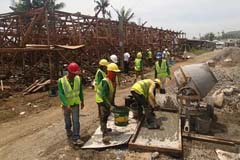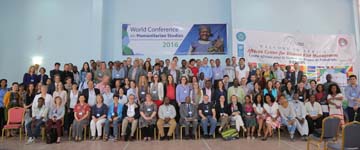Disaster Affected Communities Should Be at Center of Crisis Response, Gomez Says at IHSA Conference
2016.05.19
The fourth conference of the International Humanitarian Studies Association (IHSA), a network of humanitarian crisis researchers, was held March 5-8, 2016, in Addis Ababa, Ethiopia, and JICA Research Institute Research Fellow Oscar A. Gomez participated.
Based on the results of the research projects he is taking part in - "Comparative Study of Humanitarian Crisis Management from the Perspective of Bilateral Cooperation Agencies" and "Human Security in Practice: East Asian Experiences" - Gomez stressed the importance of understanding what the continuum of humanitarian crisis management is (seamless implementation of relief, reconstruction and prevention) and of putting disaster affected communities at the center of such crisis management (Note 1).

Reconstruction assistance is provided to the Philippines devastated by Typhoon Yolanda
The IHSA organized various panel discussions based on four major themes: humanitarian crises and development, conflict and humanitarianism, the implications of climate change for humanitarian studies, and "New Partnerships; New Technologies; Professionalism in Crisis Response."
Gomez gave a presentation about the continuum as part of the panel discussion "Governance of Humanitarian Action: Global, Regional and Domestic Approaches," which was included in the "humanitarian crises and development" theme.
"There is a common understanding among people involved in humanitarian crisis management that relief alone is not enough, and that a continuum is important. However, ambiguity about the understanding of the continuum and the lack of a common agreement hampers progress on the ground," Gomez said.
Gomez compared the understanding of the continuum as generally discussed in the field of humanitarian assistance with similar ideas in the fields of disaster risk reduction and peace building. Based on this comparison, he showed the parallel existence of two viewpoints in these three approaches: one focused on actors involved in crisis response and the other focused on changing stages of assistance (phases). Moreover, he suggested that the non-linearity of the process is not easy to internalize, especially when the continuum is thought about in relation to actors. He also showed that the position of prevention is not clearly defined as a stage in crisis management.
Gomez made the claim that to achieve a continuum, the most important thing is that disaster affected communities play a central role, while other partnerships between and within supporting actors can be of help, but never replace locals.
In the panel discussion "Locally-led Humanitarian Action: The future, or folly?" - part of the theme "New Partnerships; New Technologies; Professionalism in Crisis Response" - Gomez used the example of the Great East Japan Earthquake to bring up the importance of conducting crisis response with disaster affected areas and disaster victims playing a central role.

Participants of the conference
Gomez analyzed aid for the Great East Japan Earthquake within three categories: traditional aid consisting of people, goods and funds; nontraditional aid consisting of specialized aid for the nuclear accident and other purposes; and non-rejectable aid that arrived via individuals, companies and nongovernmental organizations. He pointed out that with regard to traditional assistance, foreign teams and the provision of goods were not effective and rejection may have been better. Non-traditional aid was easier to utilize because it was received through specialized channels. By channeling non-rejectable aid through the Japanese Red Cross, Japan Platform and JANIC (Note 2), this kind of aid was matched as much as possible to the needs of the disaster affected area, he said. However, non-rejectable aid will be an issue in the future, along with risk communication during crises.
"If aid is given with the donors playing the central role, it is not possible to achieve a crisis response centered on the disaster affected communities. It is important to carry out crisis response centered on the locals, including by empowering the disaster affected communities. Also, these communities need to have the right to reject aid they don't need in order to make the most of the crisis management process" Gomez said.
Note 1: As used in this article, crisis refers not only to disasters following natural hazards, but also to armed conflict.
Note 2: Japan Platform is a platform organization established by NGOs, private sectors and the Ministry of Foreign Affairs. It assisted NGOs and NPOs, coordinated among them and served as a pipeline with the government during the Great East Japan Earthquake. JANIC is an association of Japanese NGOs that work in international cooperation, which also took part in local projects after the GEJE.

事業事前評価表(地球規模課題対応国際科学技術協力(SATREPS)).国際協力機構 地球環境部 . 防災第一チーム. 1.案件名.国 名: フィリピン共和国.

事業事前評価表(地球規模課題対応国際科学技術協力(SATREPS)).国際協力機構 地球環境部 . 防災第一チーム. 1.案件名.国 名: フィリピン共和国.

事業事前評価表(地球規模課題対応国際科学技術協力(SATREPS)).国際協力機構 地球環境部 . 防災第一チーム. 1.案件名.国 名: フィリピン共和国.

事業事前評価表(地球規模課題対応国際科学技術協力(SATREPS)).国際協力機構 地球環境部 . 防災第一チーム. 1.案件名.国 名: フィリピン共和国.

事業事前評価表(地球規模課題対応国際科学技術協力(SATREPS)).国際協力機構 地球環境部 . 防災第一チーム. 1.案件名.国 名: フィリピン共和国.
scroll